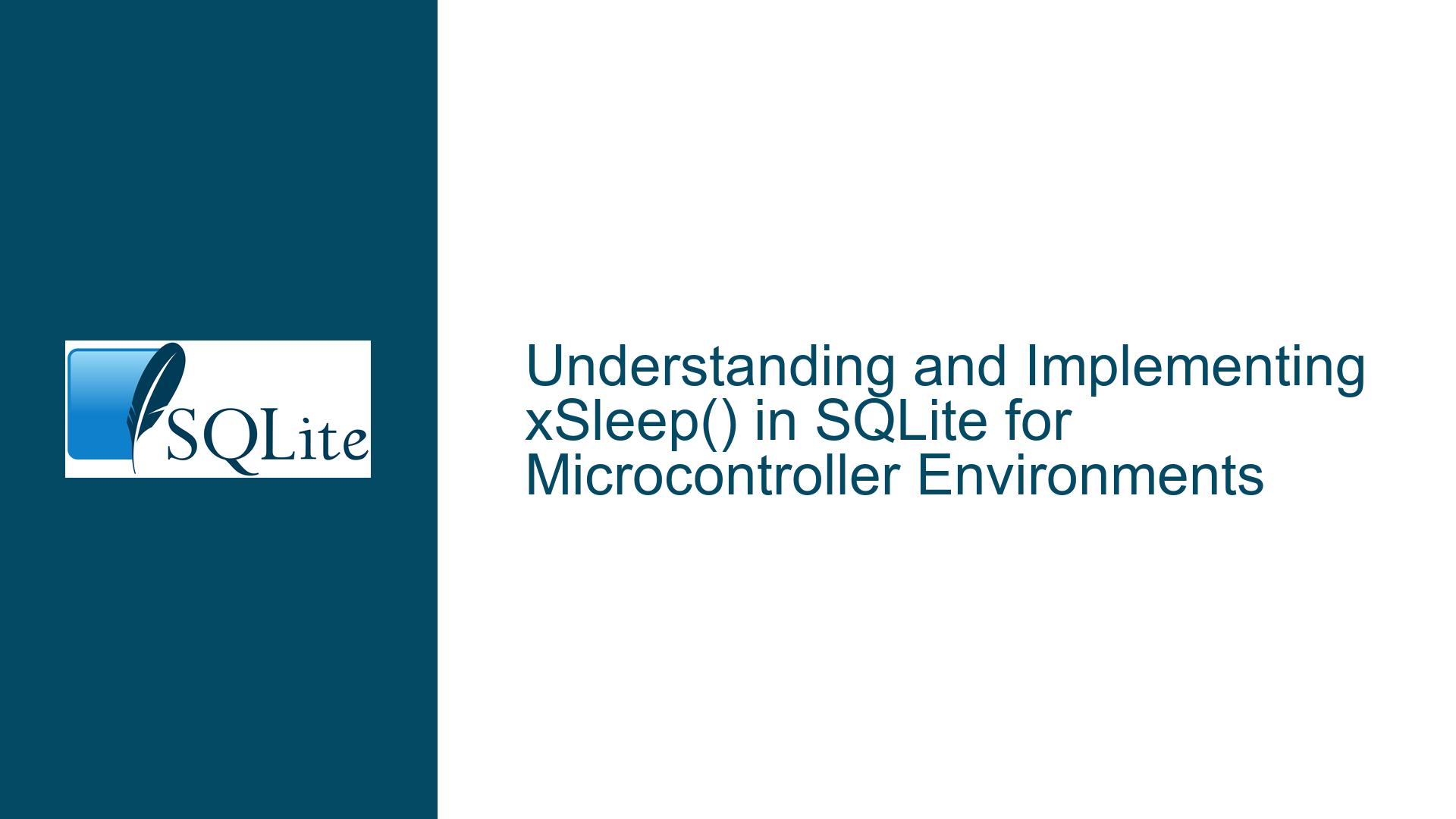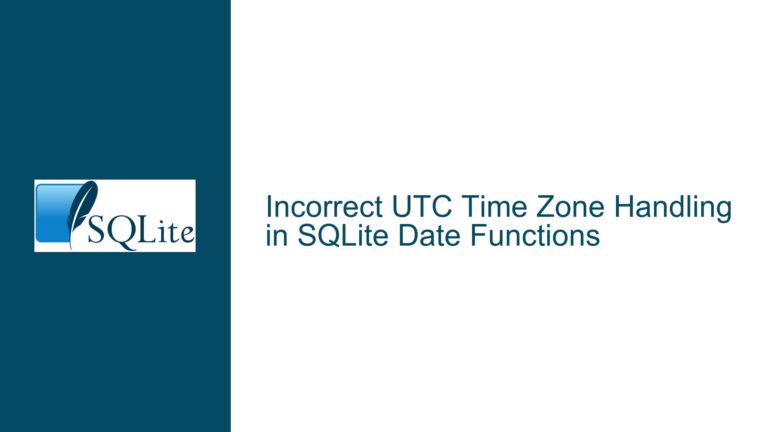and Implementing xSleep() in SQLite for Microcontroller Environments
The Role of xSleep() in SQLite’s Virtual File System (VFS)
The xSleep() function is a critical component of SQLite’s Virtual File System (VFS) layer, which abstracts the underlying operating system’s file I/O operations. The primary intent of xSleep() is to introduce a delay, typically in scenarios where SQLite needs to wait for a lock to be released. This is particularly relevant in multi-threaded or multi-process environments where concurrent access to the database can lead to contention. The function allows SQLite to implement a backoff strategy, reducing the frequency of lock acquisition attempts and thereby minimizing CPU usage and contention.
In a typical implementation, xSleep() is used in conjunction with SQLite’s busy handler mechanism. When a thread or process encounters a locked resource, it invokes the busy handler, which may call xSleep() to wait for a specified duration before retrying the operation. This mechanism is essential for ensuring that SQLite can handle concurrent access gracefully, without resorting to busy-waiting or other inefficient strategies.
However, the implementation of xSleep() can vary significantly depending on the underlying system. In environments with a full-featured operating system, xSleep() can leverage system calls like usleep() or Sleep() to introduce precise delays. In contrast, in resource-constrained environments such as microcontrollers without a real-time operating system (RTOS), implementing xSleep() becomes more challenging. The lack of a meaningful sleep mechanism forces developers to consider alternative approaches, such as making xSleep() a no-op or using a busy loop to approximate the delay.
Challenges in Implementing xSleep() on Microcontroller Systems
Implementing xSleep() on microcontroller systems presents several challenges, primarily due to the absence of an RTOS or other mechanisms for precise timing. In such environments, the traditional approach of using system calls to introduce delays is not feasible. Instead, developers must choose between two suboptimal options: making xSleep() a no-op or using a busy loop to wait for the required time.
Making xSleep() a no-op is the simpler of the two options, but it comes with significant trade-offs. A no-op implementation effectively disables the backoff mechanism, which can lead to increased contention and reduced performance in scenarios where concurrent access is possible. This approach is only viable in environments where concurrent access is guaranteed not to occur, such as single-threaded applications with exclusive access to the database.
Using a busy loop to approximate the delay is a more complex approach, but it introduces its own set of challenges. Busy-waiting consumes CPU cycles, which can be problematic in resource-constrained environments where power efficiency is a concern. Additionally, achieving millisecond-resolution delays with a busy loop can be difficult, as the accuracy of the delay depends on the clock speed and other factors that may vary between microcontroller models.
Another consideration is the impact of xSleep() on the overall system behavior. In multi-threaded or multi-process environments, the behavior of xSleep() can significantly affect the performance and reliability of the database. For example, if xSleep() introduces too much delay, it can lead to increased latency and reduced throughput. Conversely, if xSleep() introduces too little delay, it can lead to increased contention and reduced performance.
Strategies for Implementing xSleep() in Microcontroller Environments
Given the challenges associated with implementing xSleep() on microcontroller systems, developers must carefully consider the specific requirements and constraints of their environment. One approach is to make xSleep() a no-op, but this should only be done in environments where concurrent access is guaranteed not to occur. In such cases, the lack of a backoff mechanism is unlikely to cause issues, as there will be no contention for locks.
Another approach is to use a busy loop to approximate the delay, but this should be done with caution. Developers should carefully calibrate the busy loop to achieve the desired delay with minimal CPU usage. This may involve using low-level timing mechanisms, such as hardware timers or cycle-counting loops, to achieve millisecond-resolution delays. However, this approach can be complex and may require significant effort to implement correctly.
In some cases, it may be possible to leverage external hardware or software mechanisms to implement xSleep(). For example, some microcontrollers support low-power modes that can be used to introduce delays with minimal CPU usage. Alternatively, developers may be able to use external timing devices, such as real-time clocks (RTCs), to achieve precise delays. However, these approaches may not be feasible in all environments, and they may introduce additional complexity and cost.
Ultimately, the choice of implementation strategy depends on the specific requirements and constraints of the environment. Developers must carefully weigh the trade-offs between simplicity, performance, and power efficiency when implementing xSleep() on microcontroller systems. By understanding the role of xSleep() in SQLite’s VFS layer and the challenges associated with implementing it in resource-constrained environments, developers can make informed decisions that ensure the reliable and efficient operation of their database applications.
Detailed Analysis of xSleep() Implementation Options
When implementing xSleep() in a microcontroller environment, developers must consider the specific requirements of their application, including the need for precise timing, power efficiency, and the potential for concurrent access. The following sections provide a detailed analysis of the two primary implementation options: making xSleep() a no-op and using a busy loop to approximate the delay.
Making xSleep() a No-Op
Making xSleep() a no-op is the simplest implementation option, but it is only viable in environments where concurrent access to the database is guaranteed not to occur. In such cases, the lack of a backoff mechanism is unlikely to cause issues, as there will be no contention for locks. This approach is particularly well-suited for single-threaded applications with exclusive access to the database, such as embedded systems with a single task or process.
However, making xSleep() a no-op can lead to increased contention and reduced performance in environments where concurrent access is possible. For example, if the application is later extended to support multiple threads or processes, the lack of a backoff mechanism can lead to frequent lock contention and reduced throughput. Additionally, in environments where the database is accessed by external systems or devices, the lack of a backoff mechanism can lead to increased latency and reduced reliability.
Despite these limitations, making xSleep() a no-op can be a viable option in certain scenarios. For example, in applications where the database is only accessed sporadically and the risk of contention is low, the simplicity of a no-op implementation may outweigh the potential drawbacks. Additionally, in environments where power efficiency is a primary concern, the lack of a busy loop can help to minimize CPU usage and extend battery life.
Using a Busy Loop to Approximate the Delay
Using a busy loop to approximate the delay is a more complex implementation option, but it can provide more precise control over the timing of xSleep(). This approach is particularly well-suited for environments where concurrent access to the database is possible, as it allows SQLite to implement a backoff mechanism that reduces contention and improves performance.
However, using a busy loop to approximate the delay introduces several challenges. First, busy-waiting consumes CPU cycles, which can be problematic in resource-constrained environments where power efficiency is a concern. Additionally, achieving millisecond-resolution delays with a busy loop can be difficult, as the accuracy of the delay depends on the clock speed and other factors that may vary between microcontroller models.
To address these challenges, developers can use low-level timing mechanisms, such as hardware timers or cycle-counting loops, to achieve precise delays with minimal CPU usage. For example, some microcontrollers support hardware timers that can be used to generate interrupts at regular intervals, allowing the application to implement a precise delay without consuming CPU cycles. Alternatively, developers can use cycle-counting loops to achieve precise delays, but this approach requires careful calibration to account for variations in clock speed and other factors.
Despite these challenges, using a busy loop to approximate the delay can be a viable option in environments where concurrent access to the database is possible. By carefully calibrating the busy loop and using low-level timing mechanisms, developers can achieve precise delays with minimal CPU usage, ensuring that the database operates efficiently and reliably.
Conclusion
Implementing xSleep() in a microcontroller environment presents several challenges, but with careful consideration of the specific requirements and constraints of the environment, developers can choose an implementation strategy that ensures the reliable and efficient operation of their database applications. Whether making xSleep() a no-op or using a busy loop to approximate the delay, developers must weigh the trade-offs between simplicity, performance, and power efficiency to make informed decisions that meet the needs of their application. By understanding the role of xSleep() in SQLite’s VFS layer and the challenges associated with implementing it in resource-constrained environments, developers can ensure that their database applications operate efficiently and reliably, even in the most challenging conditions.






